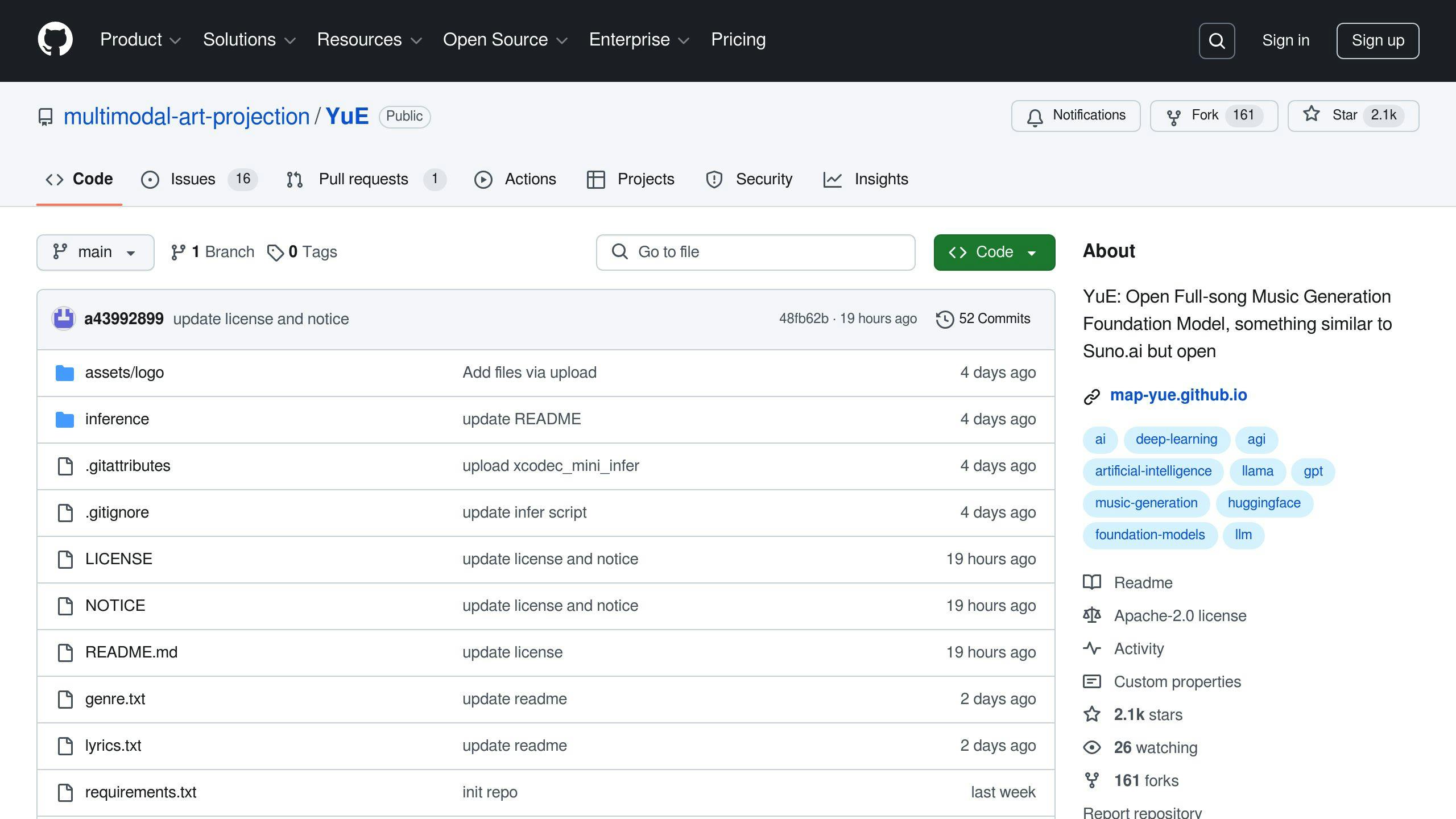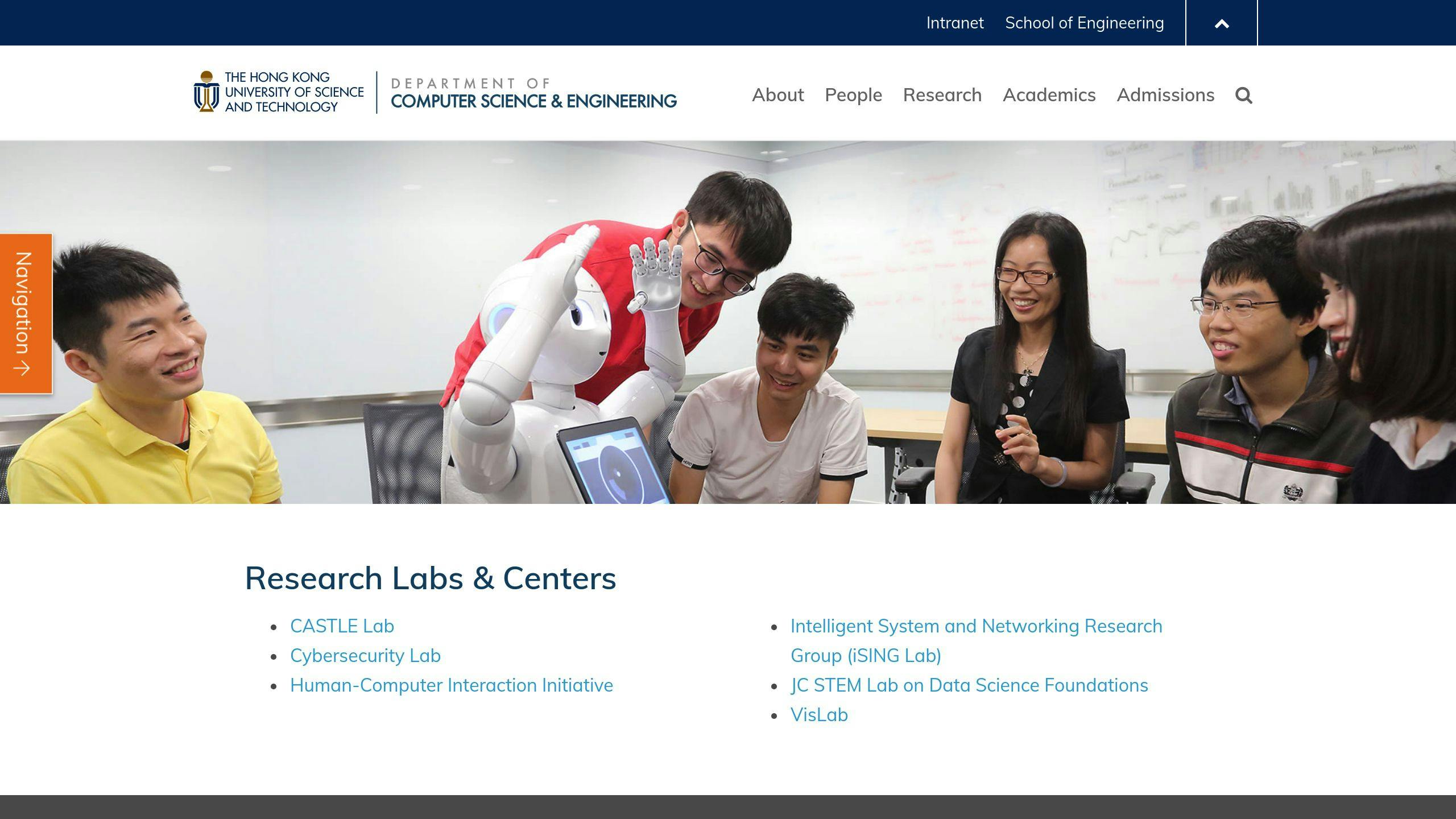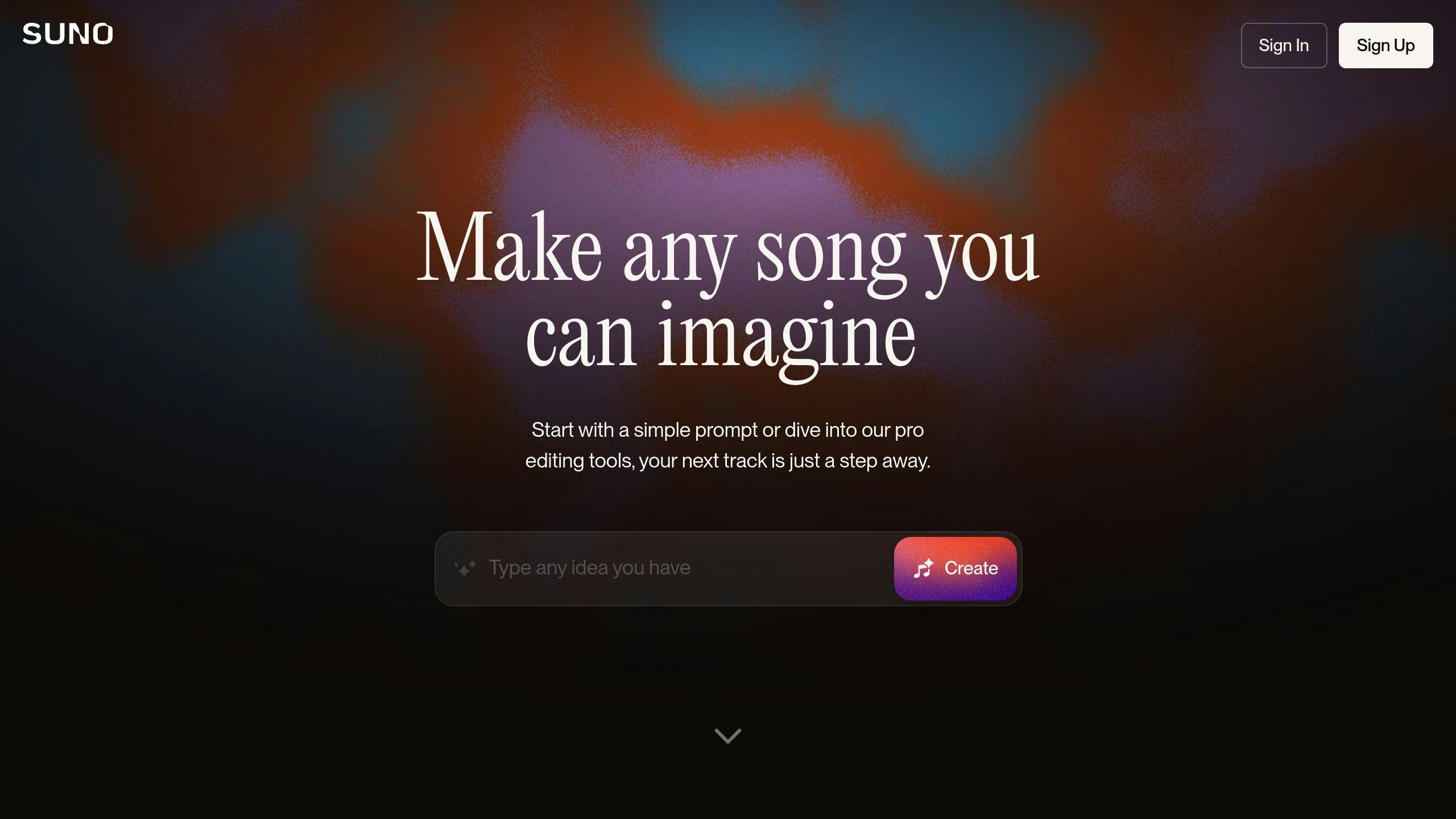YuE is a new open-source AI music model by HKUST/M-A-P that generates complete songs, including vocals and instruments, from lyrics. It stands out for being free to use under a Creative Commons license, multilingual (supporting English, Mandarin, Cantonese, Japanese, and Korean), and offering community-driven improvements. Here’s how it compares to other major players:
- YuE: Open-source, free, focuses on accessibility and flexibility, but sound quality can vary.
- Suno v4: Closed-source, excels in sound quality and structured songs but requires a subscription.
- Udio: Closed-source, professional-grade tools and customization, but locked behind paid plans.
Quick Comparison
| Feature | YuE | Suno v4 | Udio |
|---|---|---|---|
| Licensing | Open-source, free | Closed-source, paid | Closed-source, paid |
| Sound Quality | Standard | High-quality | Professional-grade |
| Multilingual | Yes | Limited | No |
| Customization | Community-driven tweaks | Built-in collaboration | Advanced editing tools |
| Cost | Free | $10-30/month | $10-30/month |
YuE challenges closed-source platforms by making advanced music generation accessible, offering a strong alternative for developers and creators alike.
Yue 7b: Generate Songs with music from Lyrics for FREE!

1. YuE by HKUST/M-A-P

YuE is an open-source music generation model designed to create complete songs with impressive precision. At its core, it uses a semantically enhanced audio tokenizer, which cuts down on training costs and speeds up the learning process.
The model introduces two standout features. First, the dual-token technique ensures that vocal and instrumental tracks stay in sync without needing to modify the Llama decoder-only architecture. Second, the lyrics-chain-of-thoughts method allows the model to generate songs step by step while staying aligned with lyrical prompts.
YuE delivers efficient performance, generating 30 seconds of audio in about 150 seconds on an H800 GPU. It handles a variety of musical styles with ease, as highlighted in tracks like "Quiet Evening" and "Step Back", which demonstrate its ability to maintain musical flow across genres like pop, metal, and hip-hop [1].
The model also supports multilingual capabilities, as shown in tracks like "酷佬", which fluidly combines Mandarin and English [1][2]. Users can tweak parameters to match their GPU resources for better performance [3].
2. Suno v4

Suno v4 marks a new step forward in AI music generation, prioritizing high-quality sound and realistic vocal performance. Unlike YuE, Suno v4 operates as a closed-source model, delivering better sound fidelity but sacrificing the openness and adaptability of open-source alternatives.
One standout feature is its ability to collaborate with users. You can upload your own recordings – like vocal tracks or loops – and work alongside the AI to create music. This makes it a great tool for both hobbyists and professional producers alike [4].
The model is also highly capable of generating original music across different genres using simple text prompts. However, it tends to favor Western musical styles and struggles with accurately capturing non-Western traditions [5].
| Feature | Strengths | Drawbacks |
|---|---|---|
| Sound Quality & Genres | High-quality audio with enhanced stereo effects; excels in Western styles | Demands significant processing power; limited support for non-Western genres |
| Collaboration | Allows users to upload personal audio for co-creation | Closed-source system limits community involvement |
| Copyright Management | Progressing toward industry standards | Legal challenges with copyright and voice imitation |
Rebecca Hu, the Project Manager, comments on the industry’s hesitations:
"The entire recording industry remains cautious about AI music" [4]
This caution highlights ongoing concerns regarding copyright and the ethical use of AI in music production. Issues like voice imitation and copyright disputes remain central as Suno v4’s developers work to address these challenges and stay competitive.
While the closed-source approach ensures tighter control over quality, it also limits transparency and community input. Suno v4 focuses on delivering exceptional sound and collaboration tools, while Udio takes a different path by emphasizing accessibility and fresh approaches to AI music.
sbb-itb-5392f3d
3. Udio
Udio, created by former Google DeepMind engineers, has become a notable name in AI music generation. By teaming up with well-known artists, the platform has improved its tools and secured $10 million in funding. One standout achievement? "Verknallt in einen Talahon" by Austrian producer Butterbro – the first AI-generated song to crack the German Top 50 [6].
| Feature | Capabilities | Limitations |
|---|---|---|
| Generation Length | Up to 15 minutes with udio-32 model | Requires premium subscription |
| Audio Processing | Uploads audio as song starters | Limited to paid plans |
| Customization | Edit and expand specific sections | Restrictions based on plan |
Udio offers three pricing options: Free (10 daily credits), Standard ($10/month for 1200 credits), and Pro ($30/month for 4800 credits). Premium plans unlock perks like longer tracks and simultaneous processing.
Two standout features set Udio apart: section modification, which lets users tweak specific parts of a track, and composition extension, where the AI builds on existing ideas to create longer pieces. However, recent benchmarks show it falls short of Suno v3.5 in sound quality and text-audio alignment according to listener preferences [7].
"AI has become a part of the creative workflow for 36.8% of music producers." – Market.us
This statistic underscores AI’s growing role in professional music production. Unlike YuE, which uses open-source licensing, Udio’s paid plans let users release tracks commercially without requiring attribution. This appeals to creators looking for more freedom in how they use their work.
Positioned between Suno’s high-quality, closed-source model and YuE’s open-source approach, Udio caters to a mix of user needs. Its subscription model strikes a balance, offering flexibility but also creating limitations depending on the user’s budget and goals. This middle-ground approach reflects the variety of demands in the evolving world of AI music generation.
Advantages and Disadvantages
The world of AI music generation offers three standout platforms – YuE, Suno v4, and Udio – each catering to different needs with their own strengths and trade-offs.
| Feature | YuE | Suno v4 | Udio |
|---|---|---|---|
| Licensing | Open-source, flexible usage | Closed-source, subscription-based | Closed-source, subscription-based |
| Sound Quality | Creative but inconsistent on complex tracks | High-quality with added effects | High-fidelity, professional-grade |
| Vocal Quality | Standard quality | Digital sound with auto-tune effects | Superior vocal replication |
| Song Structure | Basic composition | Full songs with clear structure | Drifting melodies, editable sections |
| Customization | Community-driven improvements | Extensive built-in features | Advanced editing capabilities |
| Cost | Free | $10-30/month | $10-30/month |
YuE stands out for its open-source model, which has become a cornerstone in the AI music community. With 97% of modern applications incorporating open-source components, YuE’s accessibility is a game-changer. Developers can tweak and integrate it into workflows while relying on community contributions for quality control.
Suno v4 excels in generating complete, structured songs. Its ability to create clear verse-chorus arrangements makes it ideal for quick music ideation. However, its vocal quality leans digital due to heavy processing. Features like section replacement and multiple take auditions add to its appeal for users seeking both speed and creativity.
"Suno has always been more ‘creative’ than Udio, likely because of its broad, less-restricted training."
Udio offers unmatched audio fidelity and professional-grade tools. Its high-quality output and advanced editing options make it a go-to for professional music production. Collaborative tools and support for extended song lengths make it especially useful for team projects.
Ultimately, the choice depends on your goals. YuE is perfect for developers needing flexibility and low costs. Suno v4 suits those looking for quick, creative outputs, while Udio is tailored for professionals demanding top-tier sound and detailed editing.
These platforms reflect the varied needs of AI music creators, paving the way for exciting advancements in generative music technology.
Conclusion
YuE marks a turning point in AI music generation, offering an open-source option in a space largely controlled by closed-source platforms. Developed by HKUST/M-A-P, YuE combines accessibility with forward-thinking development, shaking up an industry traditionally reliant on proprietary models.
Organizations leveraging open-source tools report a 51% positive ROI, compared to 41% for those sticking to closed systems [1]. YuE’s community-driven approach not only reduces costs but also sparks faster progress and greater transparency – addressing critical challenges in AI music creation.
"Open-source tools enable cost-effective, high-velocity AI adoption." – JJ Asghar, IBM Research [1]
As AI music continues to advance, YuE’s open-source foundation is well-suited for the shift toward smaller, more efficient AI models that balance energy use with strong performance. By focusing on accessibility and progress, YuE offers a clear alternative to the exclusivity of platforms like Suno and Udio.
YuE showcases the impact of open collaboration in driving technology forward, challenging the dominance of closed-source solutions in high-end AI music generation.

